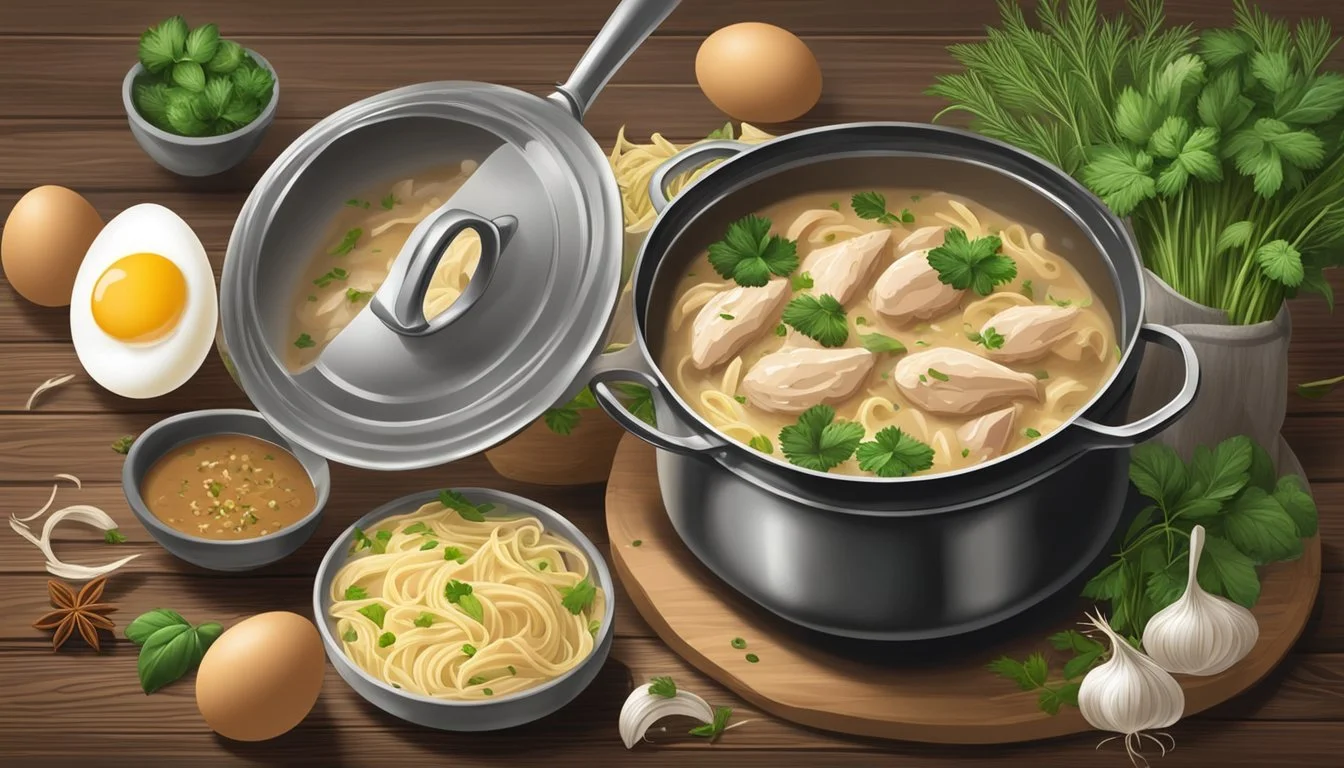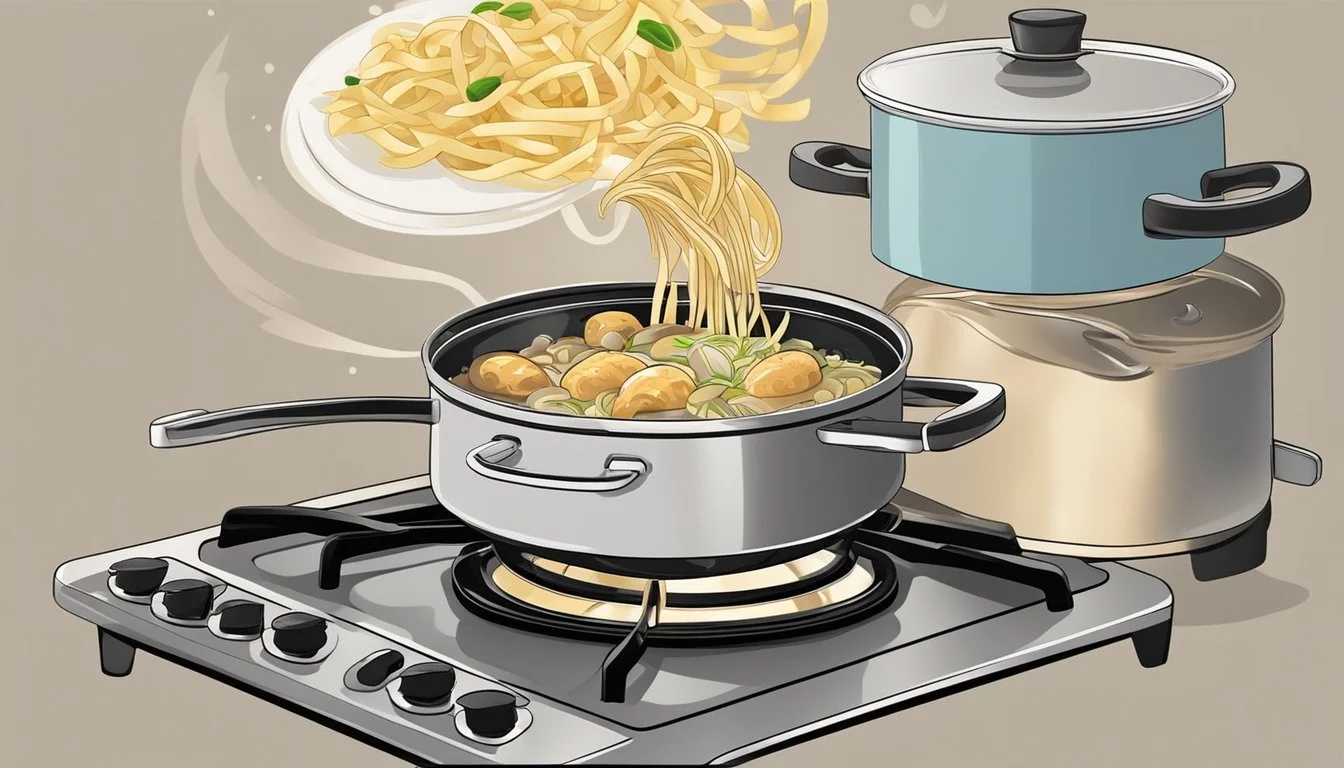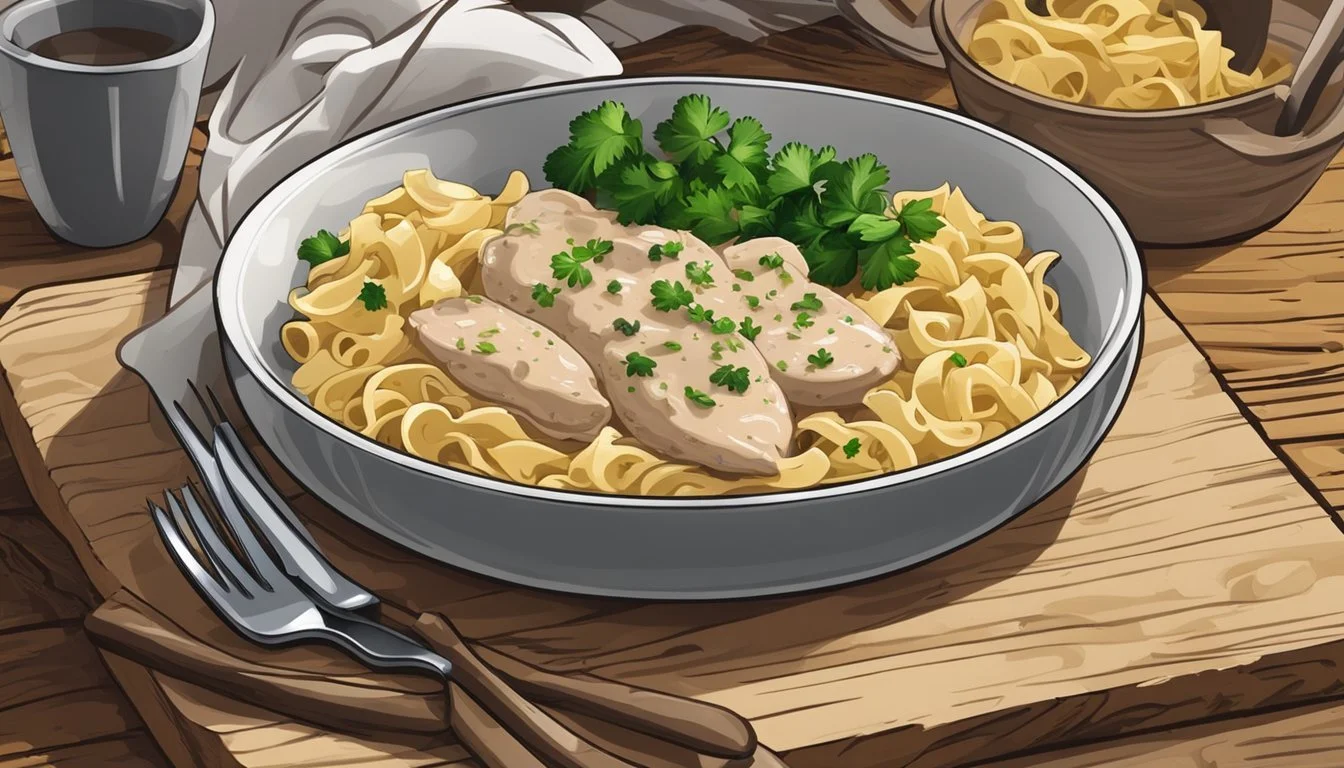How Long Does Chicken Stroganoff with Egg Noodles Last?
Storage Tips and Guidelines
Chicken Stroganoff with egg noodles is a beloved comfort food that combines tender pieces of chicken with a creamy, savory sauce. It's an excellent dish for family dinners or a gathering of friends. When stored properly in the refrigerator, this dish can last up to 3 to 4 days.
The combination of rich flavors and textures in Chicken Stroganoff makes it a meal worth savoring. Egg noodles pair perfectly with the creamy sauce, enhancing each bite. Proper storage is key to maintaining its deliciousness, so make sure to cool the dish to room temperature before refrigerating it.
To ensure the best quality, store the Chicken Stroganoff in airtight containers. When reheating, do so gently to preserve the sauce's creamy consistency and the tenderness of the chicken. This way, you can continue to enjoy this hearty and delicious meal even a few days after it was first made.
Understanding Chicken Stroganoff
Chicken Stroganoff is a flavorful dish with roots in Russian cuisine, characterized by its savory sauce and creamy texture. This section will explore its origin, key ingredients, and common variations.
Origin and Popularity
Chicken Stroganoff is an adaptation of the traditional Beef Stroganoff, a Russian dish named after the Stroganov family. Beef Stroganoff dates back to the mid-19th century and features beef cooked in a creamy sauce with sour cream and mustard.
As Chicken Stroganoff emerged, it quickly gained popularity for its lighter protein alternative. The dish is now enjoyed worldwide, especially in households looking for a comforting yet relatively simple dinner option.
Classic Ingredients
The main ingredients for Chicken Stroganoff include chicken breasts, egg noodles, sour cream, and a variety of seasonings like Dijon mustard and paprika. The chicken is often dredged in flour and spices before being cooked until golden brown.
The creamy sauce is a combination of the drippings from the chicken, broth, sour cream, and often includes onions and mushrooms for added depth in flavor. Dijon mustard and paprika are key for achieving the dish’s signature savory taste.
Variations and Substitutes
While the classic recipe includes sour cream and Dijon mustard, variations can accommodate different dietary needs and preferences. For a lighter version, Greek yogurt can replace sour cream, offering a similarly creamy texture with less fat.
Vegetarian versions might use mushrooms or tofu instead of chicken. Additionally, gluten-free noodles can substitute traditional egg noodles. Some recipes include different spices or herbs, allowing home cooks to tailor the meal to their tastes, ensuring the dish remains versatile and accessible.
Preparing the Dish
Preparing a delicious Chicken Stroganoff involves selecting high-quality ingredients, employing effective cooking techniques, and properly assembling all components.
Selecting Quality Ingredients
Quality ingredients make a difference in flavor and texture. For chicken stroganoff, choose fresh chicken breasts, ensuring they are free of any off smells or discoloration. Fresh mushrooms like cremini or baby bella add earthy richness. Opt for whole garlic cloves and fresh onions for robust flavors.
Use all-purpose flour to coat the chicken, which helps in achieving a nice sear and thickening the sauce. For the sauce, chicken broth provides depth, and sour cream adds creaminess. Always have good-quality olive oil and butter on hand for sautéing.
Cooking Techniques
Effective techniques bring out the best flavors. Begin by heating olive oil in a large skillet over medium heat. Sear the chicken breasts until brown on both sides. This step locks in juices and develops a rich flavor base.
After removing the chicken, add butter to the skillet, and sauté chopped onions and mushrooms until tender. Incorporate minced garlic in the last minute to avoid burning. Sprinkle all-purpose flour over the mixture; it helps to thicken the sauce when you stir in chicken broth gradually.
Assembling the Stroganoff
Assembly ensures all components meld perfectly. Return the seared chicken to the skillet, simmer in the sauce until fully cooked through. Check seasoning, and add salt and pepper as needed. Stir in sour cream gently, ensuring it doesn’t curdle, to achieve a smooth texture.
Prepare egg noodles as per package instructions. Once cooked and drained, toss with a bit of butter to prevent sticking. Serve the creamy chicken stroganoff over these warm, buttered noodles. Garnish with fresh parsley if desired for a pop of color and added freshness.
Choosing the Right Noodles
Selecting the appropriate type of noodle for chicken stroganoff can significantly impact the dish's texture, flavor, and overall enjoyment. Different noodles offer various benefits in terms of cooking time, flavor absorption, and dietary preferences.
Egg Noodles Fundamentals
Egg noodles are the classic choice for chicken stroganoff. They cook quickly and have a tender yet firm texture that complements the creamy sauce. When cooked al dente, they provide a pleasant bite that holds up well under the weight of the sauce and chicken.
Egg noodles have a rich taste due to the inclusion of eggs and pair well with the dish’s savory flavors. They also absorb the sauce effectively, ensuring each bite is flavorful. The wide, flat surface area of egg noodles makes them ideal for holding onto the sauce, chicken, and mushrooms.
Alternatives to Egg Noodles
For those seeking different textures or dietary needs, several alternatives to egg noodles can be considered. Fettuccine offers a similar flat shape, making it a good substitute that still provides a hearty base. Rice noodles provide a gluten-free option and have a delicate texture that pairs well with the creamy sauce.
Gluten-free pasta comes in various shapes, including spirals and shells, providing versatility for those with gluten sensitivities. For those preferring a low-carb option, zucchini noodles or mashed potatoes offer a nutritious alternative. Both options complement the chicken stroganoff without overshadowing it.
Choosing the right noodle can enhance the dish, ensuring a pleasant dining experience, whether sticking to the traditional egg noodles or exploring new alternatives.
Storage and Preservation
Proper storage and preservation of chicken stroganoff with egg noodles ensure food safety and maintain flavor and texture. Key methods include cooling and packaging, refrigeration, and freezing.
Proper Cooling and Packaging
After cooking, chicken stroganoff with egg noodles should be cooled promptly. Leaving the dish at room temperature for too long increases the risk of bacterial growth. Aim to cool the dish within two hours.
Use shallow containers to ensure even cooling. Transfer the cooled stroganoff to air-tight containers. This prevents moisture loss and protects against contaminants. Label containers with the date for easy tracking.
Covering the dish with a tight-fitting lid or plastic wrap helps maintain freshness. Proper packaging plays a crucial role in preserving both the texture and taste of the dish.
Refrigeration Best Practices
For short-term storage, keep chicken stroganoff with egg noodles in the refrigerator. Set the temperature to 40°F (4°C) or below to slow bacterial growth. Properly stored in air-tight containers, the dish can last up to 3-4 days.
Place the dish on a middle shelf where the temperature is more consistent. Avoid the refrigerator door where temperature fluctuations are common.
Check for spoilage signs before consuming leftovers. Reheat the dish to an internal temperature of 165°F (74°C). This helps kill any potential bacteria that might have developed during storage.
Freezing for Long-Term Storage
For longer preservation, freeze chicken stroganoff with egg noodles. Divide the dish into meal-sized portions. Place portions in heavy-duty freezer bags or air-tight containers, removing as much air as possible to prevent freezer burn.
Frozen chicken stroganoff can last 2-3 months in the freezer, retaining its quality. Label with the date of freezing for easy reference.
When ready to eat, thaw the dish overnight in the refrigerator. Reheat thoroughly in a skillet or the microwave. Ensure it reaches an internal temperature of 165°F (74°C) before serving to ensure food safety. Proper freezing allows for convenient and safe future meals.
Serving Suggestions
Enhancing chicken stroganoff with egg noodles involves thoughtful accompaniments and careful presentation to create an appealing and satisfying meal.
Accompaniments
Pairing chicken stroganoff with the right accompaniments is essential for a well-rounded meal.
Roasted vegetables such as carrots, Brussels sprouts, or bell peppers add color and nutritional value to your plate. They provide a contrasting texture that complements the creamy stroganoff. Savory bread, like a warm, crusty baguette or garlic bread, is excellent for soaking up the flavorful sauce.
Consider including a fresh green salad with a light vinaigrette. This helps balance the richness of the stroganoff and provides a refreshing contrast.
Egg noodles absorb the sauce well, ensuring each bite is flavorful. Ensure they're cooked al dente for the best texture.
Presentation Tips
Creating an inviting presentation enhances the dining experience significantly. Begin by layering the egg noodles neatly on the plate or in a bowl, forming a nest-like shape.
Add the chicken stroganoff on top, making sure to showcase the mushrooms and sauce generously. Garnish with fresh parsley to add a pop of green and a hint of freshness.
Use a skillet to reheat the stroganoff if needed, maintaining the dish's texture and flavor. Arrange the roasted vegetables and bread on the side, adding visual appeal and making the meal complete.
Serve with a clean, attractive plate to ensure every element looks appetizing and well-presented.
Chicken Stroganoff Lifespan
Chicken Stroganoff, when paired with egg noodles, can have varying lifespans depending on storage conditions and handling methods. Proper storage and attention to food safety are crucial to ensure the dish remains fresh and safe to eat.
Factors Affecting Shelf Life
The shelf life of Chicken Stroganoff with egg noodles hinges on several factors. Refrigerator storage is essential; leftovers should be placed in an airtight container within 2 hours of cooking. When stored in the refrigerator at or below 40°F, the dish typically lasts for about 3-4 days.
Freezing the Chicken Stroganoff can extend its life significantly. When properly stored in airtight containers or freezer bags, it can last up to 3 months in the freezer. Ensure it's reheated to an internal temperature of 165°F before consumption. Temperature fluctuations and exposure to air can shorten the dish's lifespan.
Signs of Spoilage
Detecting spoilage in Chicken Stroganoff is critical for food safety. Look for visual cues such as color changes. Freshly cooked Chicken Stroganoff has a consistent, rich color, while spoiled portions may appear dull or discolored.
Odor is another indicator. An off or sour smell suggests bacterial growth. Texture changes should also be noted. Spoiled Chicken Stroganoff may have a slimy or mushy texture, unrelated to the sauce.
Lastly, taste is a final, but risky, measure. If any signs of spoilage are present, it's best to dispose of the dish to prevent foodborne illnesses.





